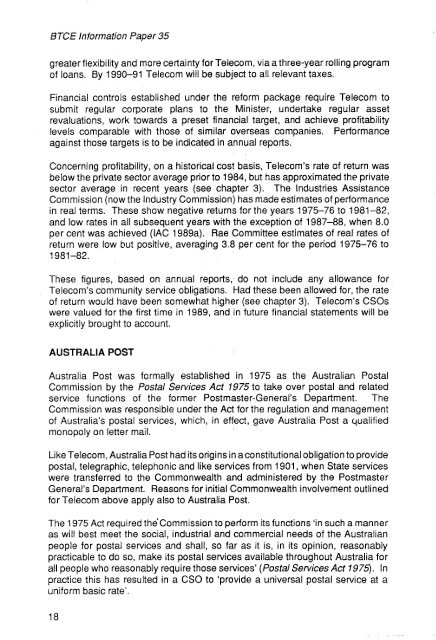PDF: 7881 KB - Bureau of Infrastructure, Transport and Regional ...
PDF: 7881 KB - Bureau of Infrastructure, Transport and Regional ...
PDF: 7881 KB - Bureau of Infrastructure, Transport and Regional ...
Create successful ePaper yourself
Turn your PDF publications into a flip-book with our unique Google optimized e-Paper software.
BTCE lnformation Paper 35greater flexibility <strong>and</strong> more certainty for Telecom, via a three-year rolling program<strong>of</strong> loans. By 1990-91 Telecom will be subject to all relevant taxes.Financial controls established under the reform package require Telecom tosubmit regular corporate plans to the Minister, undertake regular assetrevaluations, work towards a preset financial target, <strong>and</strong> achieve pr<strong>of</strong>itabilitylevels comparable with those <strong>of</strong> similar overseas companies. Performanceagainst those targets is to be indicated in annual reports.Concerning pr<strong>of</strong>itability, on a historical cost basis, Telecom’s rate <strong>of</strong> return wasbelow the private sector average prior to 1984, but has approximated the privatesector average in recent years (see chapter 3). The Industries AssistanceCommission (now the Industry Commission) has made estimates <strong>of</strong> performancein real terms. These show negative returns for the years 1975-76 to 1981-82,<strong>and</strong> low rates in all subsequent years with the exception <strong>of</strong> 1987-88, when 8.0per cent was achieved (IAC 1989a). Rae Committee estimates <strong>of</strong> real rates <strong>of</strong>return were low but positive, averaging 3.8 per cent for the period 1975-76 to1981-82.These figures, based on annual reports, do not include any allowance forTelecom’s community service obligations. Had these been allowed for, the rate<strong>of</strong> return would have been somewhat higher (see chapter 3). Telecom’s CSOswere valued for the first time in 1989, <strong>and</strong> in future financial statements will beexplicitly brought to account.AUSTRALIA POSTAustralia Post was formally established in 1975 as the Australian PostalCommission by the Postal Services Act 7975 to take over postal <strong>and</strong> relatedservice functions <strong>of</strong> the former Postmaster-General’s Department. TheCommission was responsible under the Act for the regulation <strong>and</strong> management<strong>of</strong> Australia’s postal services, which, in effect, gave Australia Post a qualifiedmonopoly on letter mail.Like Telecom, Australia Post had its origins in aconstitutional obligation to providepostal, telegraphic, telephonic <strong>and</strong> like services from 1901, when State serviceswere transferred to the Commonwealth <strong>and</strong> administered by the PostmasterGeneral’s Department. Reasons for initial Commonwealth involvement outlinedfor Telecom above apply also to Australia Post.The 1975 Act required theCommission to perform its functions ‘in such a manneras will best meet the social, industrial <strong>and</strong> commercial needs <strong>of</strong> the Australianpeople for postal services <strong>and</strong> shall, so far as it is, in its opinion, reasonablypracticable to do so, make its postal services available throughout Australia forall people who reasonably require those services’ (Postal Services Act 1975). Inpractice this has resulted in a CS0 to ‘provide a universal postal service at auniform basic rate’.18
















